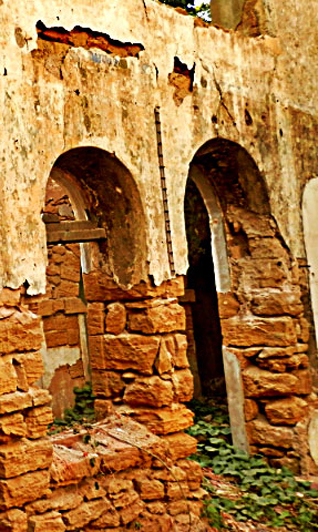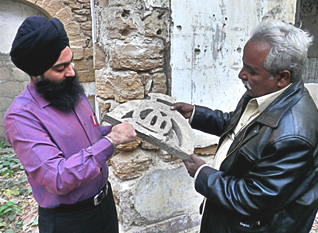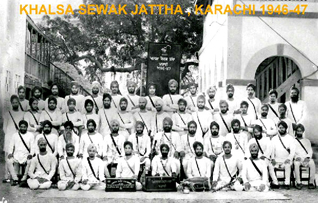
Above: The state of the gurdwara building today. Below: : The author (right) shows Ramesh Singh a piece of stonework found in the ruins.


Travel
Between A Mosque and a Madrassah:
Karachi’s Ratan Talao Gurdwara
AKHTAR BALOUCH
Karachi, Pakistan
The title of this piece must have piqued your interest. Many of you must wonder if it is even possible.
I can assure you, it is, and with emphasis.
You do not have to go very far to find out if this is in fact true, even though no web search or any other such resource will provide any information on it.
There is, however, a mention of it in Zahid Choudhary’s book. A renowned researcher, Zahid writes in Sindh Masala-e-Khud Mukhtiari Ka Aghaaz:
“There were tragic incidents of violence at the Ratan Talao, Karachi’s gurdwara for the Sikhs, where 250 Sikh men, women and children had sought refuge, awaiting their departure to Bombay. The gurdwara was set ablaze, injuring at least 70 people.”
I take pride in being well acquainted with the Ratan Talao area.
However, I never knew the locality housed a gurdwara there. Although, I did know that a gurdwara was located somewhere on a road in Karachi called the Temple Road.
Unfortunately, in post-partition Karachi, the streets and roads were renamed in such haste that finding Temple Road itself was no easy feat.
There is a Temple Road in Lahore, too – and quite known at that. Mubashir Hassan, who was Zulfiqar Ali Bhutto’s close friend and a minister in his government, used to live on Temple Road. Another minister from those days, Ghulam Nabi, lived there as well.
Whether there is or ever has been a gurdwara on that road is not known to me personally. However, this was brought to my notice by my benefactor, Mr Hussain Naqi sahib.
We are speaking of Karachi, though. Of course, there is a temple on Temple Road as well, but that, I will save for another day.
Before I get back to the story of my search of the gurdwara situated somewhere between Temple Road and the Nabi Bagh mosque, let me share a little something about the Sikhs of the pre-partition Karachi, their residential areas and their gurdwaras.
Mehmooda Rizwiya writes on page 34 of her book, Karachi - Malika-e-Mashriq:
“Punjabi Sikhs started coming to Karachi in 1930 and progressed almost instantly. They were good blacksmiths, good electricians, and woodworkers. Sadly, though, Sikhs and Muslims could not coexist peacefully in Uttar Pradesh and Punjab. Thus, in August 1947, the Sikhs had to resort to leaving Karachi once and for all.”
About the residential areas of Sikhs living in Karachi before the partition, Muhammad Usman Damohi sahib writes in the second edition of his book, Karachi Taareekh Kay Aaeenay Main:
“They [Sikhs] lived in the Lee Market. The area name Nanak Warra was also given to the place by them. They had established a school for Sikhs, and many gurdwaras in Karachi. After the partition, they all moved to India.”
One fine Sunday, I went out to treat myself to some halwa puri. I went to the halwa puri shop adjacent to the temple on Temple Road. While I sat there, I could not help observing a building in plain sight, the Government College Nabi Bagh.
Once done with breakfast, I moved towards the college. The gate was open so I entered. From experience, I almost instantly knew that the name of the college too had been changed.
There was a pathway by the outer building of the college which lead all the way to the back of the building. As I took the path and kept on it, I saw what could be called the remains of an old building. I noticed the silence in the college was nothing compared to the desolate state of this poor, worn out structure.
The roof was all rubble, and the windows were well, not windows anymore. In summary, it was all either debris or soon-to-be debris. There was a man there who was feeding shrubs to his goat. He looked at me suspiciously.
I inquired, “Sir, was this the old college building?”
He shook his head in negation, replying, “Gurdwara!”
Then, he asked who I was. I told him I was a photographer by hobby, adding if I could take a couple of pictures of the place. He said, “As many as you want.”
The man opened the door of the building-cum-rubble for me. Even though he had told me to take as many pictures as I could, I still made haste. It was only that my experience of taking pictures of things and places as such has not been very joyful.
The next day, a Monday, I visited the same college by 11 in the morning. I went to see the principal. I told him I was writing on old educational institutes and asked if I could get some details on the history of the college. The man had an expressionless face or, perhaps, his level of disinterest was more than what I had expected. He told me to drop by a week later.
He was accompanied by another man in his office. After the introduction, he told me in an Urdu overcome by a natural Sindhi accent that he teaches Urdu literature at the college. He insisted that I write on the gurdwara behind the college.
The principal gave his colleague a look and then stood up to shake my hand. It obviously meant that he wanted me to leave.
After coming out of the college, I searched my mobile phone for the number of a Sikh friend, Ramesh Singh. Unfortunately, I had lost the number. So, I got in touch with Michael Javed, four-time member of the provincial assembly on the minority quota, for Ramesh’s number.
Ramesh told me that he was in Daharki, a town in the north of Sindh, and that he would be back in Karachi in a week. He also told me that he had some pictures of the gurdwara, to which I replied that I had some of its pictures, too.
A week’s wait was difficult for me. Finally, when Ramesh Singh was back in Karachi, I accompanied Michael Javed to call on him. In the meeting, we decided that Ramesh and I would visit the gurdwara the coming Sunday.
Sunday finally arrived after another knotty wait.
Ramesh Singh and I visited the gurdwara in the evening. With the college precincts, kids were engrossed in a game of cricket. We did not disturb them and entered the building silently.
Slowly, we moved towards the gurdwara. There, Ramesh Singh told me that the gurdwara was known as the Ratan Talao Gurdwara.
He told me he had been trying to restore the gurdwara for some time now. However, he added, the Office of the Commissioner did not have any record of there ever being a gurdwara here.
With a sad smile on his face, he went on, “You must know why no records of it can be found.”
We were deep in conversation when a young man brought an imprint made of stone. It was the sacred symbol of Sikhs, Ramesh enlightened me.
The young man also told me that the symbol was embossed on all four sides of the building, but they were pulled down. He went on to tell me that the college administration had even built a classroom in the building. As proof, I was shown a blackboard inside the gurdwara building.
Ramesh and I removed some of the rubble from the floor, unearthing the marble tiles.
The ruins of the gurdwara are still there inside the Nabi Bagh College, but cannot be seen from the outside as the college building conceals it, while from the back, the place is hidden by a three-storey mosque.
The mosque is known as the Ratan Talao Mosque.
The gurdwara has completely lost its existence, hidden between a mosque and a madrassah (Islamic school).
According to Sardar Ramesh Singh, Sikhs are still living in Karachi. There are gurdwaras, too, where they go and conduct their prayer services. One of the gurdwaras is the Guru Granth Sahib Sindh Sabha, which is in Narain Pura, Ranchor Line, while the other is the Guru Nanak Gurdwara at Manora.
In 1993, Ramesh says, the voters’ lists showed that there were ten thousand Sikhs in Sindh, three thousand in Karachi alone. He is of the view that the population must have increased by now.
Currently, the Sikhs are living in Ranchor Line, Light House (the previous Light House Cinema and the current Landa Bazaar), and the residential area adjacent to the Cantt Railway Station, Narain Pura and Gulshan Mamaar.
The author, also known as the Kiranchi Wala, writes regularly for The
Dawn to bring back the long forgotten heritage of Karachi. Translated from the original Urdu by Aadarsh Ayaz Laghari.
[Courtesy: The Dawn, Edited for sikhchic.com]
March 4, 2014
Conversation about this article
1: Harinder (Punjab), March 04, 2014, 10:06 AM.
This is the fate of gurdwaras -- and other places of worship -- when Muslims over-run an area, any area, numerically. It is called the 'Demographic Islamic Invasion.' Non-Muslims turn into refugees and flee ... as we had to in 1947 ... Now, in India, the same is being repeated with the Hindu majority!
2: Rup Singh (Canada), March 04, 2014, 2:49 PM.
We should not always have a victim's attitude and blame others for everything that is happening to us. The enemy always means to undermine and destroy, but it's the enemy within that is even more dangerous. The SGPC has knowingly demolished historical gurdwaras and heritage buildings in the guise of kar seva, through illiterate kar seva babas who have no knowledge of history, engineering or architecture. The gold of Darbar Sahib did not need to be changed but it was. Why? It was a legacy of the Sikh Kingdom. The SGPC must bear some responsibility for the 1984 demolition of the Akal Takht, it was taken over and fortified on their watch. They may not have been able to prevent the eventual attack by a criminally motivated army but their inaction to stop the fortification of Akal Takht does leave many doubts. We must stop playing the helpless victim and should begin to question and hold to account our own leaders, starting at the SGPC level. They do spend a lot of the sangat's money in courts and on elections to hold onto power. Starting with them, we then follow the arrows.
3: Kaala Singh (Punjab), March 04, 2014, 9:53 PM.
With the demographic invasion going on in Punjab, soon we will be reduced to a minority even in Punjab and we may face a similar situation if this is not stopped. Sikhs are not allowed to buy land in Rajasthan, Himachal and many other states. "Riots" are engineered to chase them out of their lands and properties. While in Punjab, people from outside are buying up lands and reducing us to a minority. All this is due to the fact that the Sikh farmers have become drug addicts. With no education and no capacity to do other work, they are selling lands which others are only too happy to buy. Gone are the days when the Sikh farmer was known for his hard work and ingenuity.
4: Gurdarshan (Kuala Lumpur, Malaysia), March 05, 2014, 7:45 AM.
#1. I disagree with your comment. Malaysia, a muslim majority nation, has 125 gurdwaras for a Sikh population of about 200,000. The Muslim Malays respect the Sikhs from amongst other Indians, as the Sikhs have worked hard in nation-building ... through police and armed forces, professionals like doctors, lawyers and engineers, among others. To emphasize this point, Malaysia is one of the first countries in the world that waives the rules for a Sikh to wear a motorcycle helmet since way back in 1973/74. Thus I am of the opinion that what happened to Sikhs in Pakistan, i.e., the killing and the goings-on after the Partition, such as destruction of properties and gurdwaras, have to do much with the Congress in Hindu India, akin to the 1984 pogroms. They orchestrated the massacres in India before the news spread to Pakistan. It is not the religion but the people behind it by using religion for their advantages and popularity to be in power.
5: Sarvjit Singh (Massachusetts, USA), March 05, 2014, 11:44 AM.
In response to #2: I don't think our kaar seva babas and local Sikh sangats have the same sense of preserving our architectural heritage. This has been our way of doing things. Old gurdwaras get rebuilt with newer bricks. This concept of preserving heritage and architecture is Western in nature, not Punjabi. After 1984 there was a strong sense among Sikhs to rebuild the Harmandar Sahib and Akal Takht, which was probably the same way after Abdali's destruction. We had the Akal Takht rebuilt as a defiance against our enemies. Thus, we rise like the phoenix! But now it is the other way around - let us leave it in a broken state to preserve and show our wounds to others - sounds a little victimish. Personally, I think we should preserve anything that is related to the Gurus and rebuild where needed with the old design in mind.


